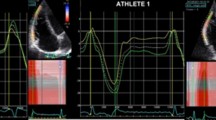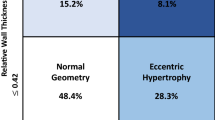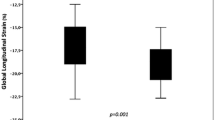Abstract
Aims
Endurance athletes develop cardiac remodeling to cope with increased cardiac output during exercise. This remodeling is both anatomical and functional and shows large interindividual variability. In this study, we quantify local geometric ventricular remodeling related to long-standing endurance training and assess its relationship with cardiovascular performance during exercise.
Methods
We extracted 3D models of the biventricular shape from end-diastolic cine magnetic resonance images acquired from a cohort of 89 triathlon athletes and 77 healthy sedentary subjects. Additionally, the athletes underwent cardio-pulmonary exercise testing, together with an echocardiographic study at baseline and few minutes after maximal exercise. We used statistical shape analysis to identify regional bi-ventricular shape differences between athletes and non-athletes.
Results
The ventricular shape was significantly different between athletes and controls (p < 1e−6). The observed regional remodeling in the right heart was mainly a shift of the right ventricle (RV) volume distribution towards the right ventricular infundibulum, increasing the overall right ventricular volume. In the left heart, there was an increment of left ventricular mass and a dilation of the left ventricle. Within athletes, the amount of such remodeling was independently associated to higher peak oxygen pulse (p < 0.001) and weakly with greater post-exercise RV free wall longitudinal strain (p = 0.03).
Conclusions
We were able to identify specific bi-ventricular regional remodeling induced by long-lasting endurance training. The amount of remodeling was associated with better cardiopulmonary performance during an exercise test.


Similar content being viewed by others
Abbreviations
- AUROC:
-
Area under receiver operator characteristic
- ARVC:
-
Arrhythmogenic right ventricle cardiomyopathies
- BSA:
-
Body surface area
- CO:
-
Cardiac output
- CPET:
-
Cardiopulmonary exercise testing
- HR:
-
Heart rate
- LH:
-
Left heart
- LOO-CV:
-
Leave one out cross validation
- LV:
-
Left ventricle
- LVGLS:
-
Left ventricular global longitudinal strain
- LVOT:
-
Left ventricular outflow tract
- MRI:
-
Magnetic resonance imaging
- PCA:
-
Principal component analysis
- PER:
-
Pulmonary extraction ratio
- PLS:
-
Partial least squares
- RA:
-
Right atria
- RH:
-
Right heart
- RV:
-
Right ventricle
- RV-FW:
-
Right ventricular free wall
- RVGLS:
-
Right ventricle global longitudinal strain
- RVOT:
-
Right ventricle outflow tract
- SA:
-
Short axis
- SSA:
-
Statistical shape analysis
- STD:
-
Standard deviation
- VO2 :
-
Oxygen uptake
References
Ainsworth BE, Haskell WL, Herrmann SD et al (2011) 2011 Compendium of physical activities. Med Sci Sport Exerc 43:1575–1581. https://doi.org/10.1249/MSS.0b013e31821ece12
Albert RK, Spiro SG, Jett JR (2008) Clinical respiratory medicine. Elsevier, New York
Badano LP, Kolias TJ, Muraru D et al (2018) Standardization of left atrial, right ventricular, and right atrial deformation imaging using two-dimensional speckle tracking echocardiography: a consensus document of the EACVI/ASE/Industry Task Force to standardize deformation imaging. Eur Heart J Cardiovasc Imaging. https://doi.org/10.1093/ehjci/jey042
Claesen G, Claus P, Ghysels S et al (2014) Right ventricular fatigue developing during endurance exercise. Med Sci Sport Exerc 46:1717–1726. https://doi.org/10.1249/MSS.0000000000000282
Cootes TF, Taylor CJ, Cooper DH, Graham J (1995) Active shape models-their training and application. Comput Vis Image Underst 61:38–59. https://doi.org/10.1006/cviu.1995.1004
Craig CL, Marshall AL, Sjöström M et al (2003) International Physical Activity Questionnaire: 12-country reliability and validity. Med Sci Sport Exerc 35:1381–1395. https://doi.org/10.1249/01.MSS.0000078924.61453.FB
D’Andrea A, La Gerche A, Golia E et al (2015) Right heart structural and functional remodeling in athletes. Echocardiography 32:11–22. https://doi.org/10.1111/echo.12226
De Craene M, Duchateau N, Tobon-Gomez C, et al (2012) SPM to the heart: Mapping of 4D continuous velocities for motion abnormality quantification. In: Proceedings of the International Symposium on Biomedical Imaging
DeLong ER, DeLong DM, Clarke-Pearson DL (1988) Comparing the areas under two or more correlated receiver operating characteristic curves: a nonparametric approach. Biometrics. https://doi.org/10.2307/2531595
Dryden L, Mardia KV (1998) Statistical shape analysis. Wiley, New York
Du Bois D, Du Bois EF (1916) A formula to estimate the approximate surface area if height and weight be known. Arch Intern Med XVII:863–871. https://doi.org/10.1001/archinte.1916.00080130010002
Ecabert O, Peters J, Weese J et al (2006) Automatic heart segmentation in CT: current and future applications. Medicamundi 50:12–17
Kovacs G, Berghold A, Scheidl S, Olschewski H (2009) Pulmonary arterial pressure during rest and exercise in healthy subjects: a systematic review. Eur Respir J 34:888–894. https://doi.org/10.1183/09031936.00145608
La Gerche A, Baggish AL, Knuuti J et al (2013) Cardiac imaging and stress testing asymptomatic athletes to identify those at risk of sudden cardiac death. JACC Cardiovasc Imaging 6:993–1007. https://doi.org/10.1016/j.jcmg.2013.06.003
La Gerche A, Burns AT, Mooney DJ et al (2012) Exercise-induced right ventricular dysfunction and structural remodelling in endurance athletes. Eur Heart J 33:998–1006. https://doi.org/10.1093/eurheartj/ehr397
La Gerche A, MacIsaac AI, Burns AT et al (2010) Pulmonary transit of agitated contrast is associated with enhanced pulmonary vascular reserve and right ventricular function during exercise. J Appl Physiol 109:1307–1317. https://doi.org/10.1152/japplphysiol.00457.2010
La Gerche A, Prior DL (2007) Exercise—is it possible to have too much of a good thing? Hear Lung Circ. https://doi.org/10.1016/j.hlc.2007.03.014
La Gerche A, Rakhit DJ, Claessen G (2017) Exercise and the right ventricle: a potential Achilles’ heel. Cardiovasc Res 113:1499–1508. https://doi.org/10.1093/cvr/cvx156
Lang RM, Badano LP, Mor-Avi V et al (2015) Recommendations for cardiac chamber quantification by echocardiography in adults: an update from the American society of echocardiography and the European association of cardiovascular imaging. Eur Heart J Cardiovasc Imaging. https://doi.org/10.1093/ehjci/jev014
Marcus RH, Korcarz C, McCray G et al (1994) Noninvasive method for determination of arterial compliance using Doppler echocardiography and subclavian pulse tracings. Validation and clinical application of a physiological model of the circulation. Circulation 89:2688–2699. https://doi.org/10.1161/01.CIR.89.6.2688
Peters J, Ecabert O, Meyer C et al (2010) Optimizing boundary detection via simulated search with applications to multi-modal heart segmentation. Med Image Anal. https://doi.org/10.1016/j.media.2009.10.004
Rhodes J, Garofano RP, Bowman FO et al (1990) Effect of right ventricular anatomy on the cardiopulmonary response to exercise: Implications for the Fontan procedure. Circulation 81:1811–1817
Robin X, Turck N, Hainard A et al (2011) pROC: an open-source package for R and S+ to analyze and compare ROC curves. BMC Bioinformatics. https://doi.org/10.1186/1471-2105-12-77
Ross RM, Beck KC, Casaburi R et al (2003) ATS/ACCP statement on cardiopulmonary exercise testing (multiple letters). Am J Respir Crit Care Med 167:1451. https://doi.org/10.1164/ajrccm.167.10.950
Sanz-de la Garza M, Giraldeau G, Marin J et al (2017) Influence of gender on right ventricle adaptation to endurance exercise: an ultrasound two-dimensional speckle-tracking stress study. Eur J Appl Physiol 117:389–396. https://doi.org/10.1007/s00421-017-3546-8
Sanz-de la Garza M, Grazioli G, Bijnens BH et al (2016) Acute, exercise dose-dependent impairment in atrial performance during an endurance race: 2D ultrasound speckle-tracking strain analysis. JACC Cardiovasc Imaging. https://doi.org/10.1016/j.jcmg.2016.03.016
Scharhag J, Schneider G, Urhausen A et al (2002) Athlete’s heart. J Am Coll Cardiol 40:1856–1863. https://doi.org/10.1016/S0735-1097(02)02478-6
Schmied C, Borjesson M (2014) Sudden cardiac death in athletes. J Intern Med 275:93–103. https://doi.org/10.1111/joim.12184
Sitges M, Merino B, Butakoff C et al (2017) Characterizing the spectrum of right ventricular remodelling in response to chronic training. Int J Cardiovasc Imaging 33:331–339. https://doi.org/10.1007/s10554-016-1014-x
Slife DM, Latham RD, Sipkema P, Westerhof N (1990) Pulmonary arterial compliance at rest and exercise in normal humans. Am J Physiol 258:H1823–H1828. https://doi.org/10.1152/ajpheart.1990.258.6.H1823
Stringer WW, Hansen JE, Wasserman K (1997) Cardiac output estimated noninvasively from oxygen uptake during exercise. J Appl Physiol 82:908–912
Varano V, Piras P, Gabriele S et al (2018) The decomposition of deformation: new metrics to enhance shape analysis in medical imaging. Med Image Anal 46:35–56. https://doi.org/10.1016/j.media.2018.02.005
Varela M, Bisbal F, Zacur E et al (2017) Novel computational analysis of left atrial anatomy improves prediction of atrial fibrillation recurrence after ablation. Front Physiol 8:68. https://doi.org/10.3389/FPHYS.2017.00068
Zhang X, Cowan BR, Bluemke DA et al (2014) Atlas-based quantification of cardiac remodeling due to myocardial infarction. PLoS ONE. https://doi.org/10.1371/journal.pone.0110243
Acknowledgements
We thank Dr. Weese and Dr. Groth from Philips Research for the segmentation tool.
Funding
This study was partially supported by the Spanish Ministry of Economy and Competitiveness (Grant DEP2013-44923-P, TIN2014-52923-R; Maria de Maeztu Units of Excellence Programme—MDM-2015-0502), el Fondo Europeo de Desarrollo Regional (FEDER), the European Union under the Horizon 2020 Programme for Research, Innovation (Grant agreement No. 642676 CardioFunXion) and Erasmus+Programme (Framework Agreement number: 2013-0040), “la Caixa” Foundation (LCF/PR/GN14/10270005, LCF/PR/GN18/10310003), Instituto de Salud Carlos III (PI14/00226, PI15/00130, PI17/00675) integrated in the “Plan Nacional I+D+I” and AGAUR 2017 SGR Grant no. 1531.
Author information
Authors and Affiliations
Contributions
ASM, MRL, and FC acquired and measured the echocardiography and MRI controls data. MSDG acquired and analyzed the echo data for the athletes. MSDG, FB, and IB acquired and analyzed the stress test. BDX, SPG, and RJP acquired and analyzed the MRI data. The SSA was done by GB, MAGB, CB, and MDC. All authors participated in the data interpretation, reading, and approval the final manuscript.
Corresponding author
Ethics declarations
Conflicts of interest
GB and MDC were working for Philips at the time of the work.
Ethical approval
All procedures performed in studies involving human participants were in accordance with the ethical standards of the institutional research committee (Comité ético de investigación clínica del Hospital Clínic de Barcelona) and with the 1964 Helsinki declaration and its later amendments or comparable ethical standards.
Additional information
Communicated by Keith Phillip George.
Publisher's Note
Springer Nature remains neutral with regard to jurisdictional claims in published maps and institutional affiliations.
Electronic supplementary material
Below is the link to the electronic supplementary material.
Supplementary file2 (AVI 790 kb)
Rights and permissions
About this article
Cite this article
Bernardino, G., Sanz de la Garza, M., Domenech-Ximenos, B. et al. Three-dimensional regional bi-ventricular shape remodeling is associated with exercise capacity in endurance athletes. Eur J Appl Physiol 120, 1227–1235 (2020). https://doi.org/10.1007/s00421-020-04335-3
Received:
Accepted:
Published:
Issue Date:
DOI: https://doi.org/10.1007/s00421-020-04335-3




